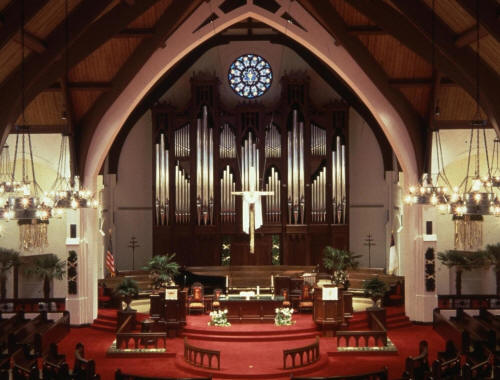|
Builder: Schantz Organ Co., Opus 696, 1965 Originally: W. W. Kimball Company, 1934 Manuals: 4 Ranks: 63 Pipes: 3651 Action: Electropneumatic Notes: By 1964, after 30 years of 16-hours-a-day service, the Kimball's mechanisms were worn out, and it was decided to rebuild the organ with extensive renovations and additions by the Schantz Organ Company. Dean Lavahn Maesch dedicated the four-manual Schantz organ on May 16, 1965. At 51 stops, 63 ranks, and 3,651 pipes, it would be the largest organ ever to occupy the chapel. The organ pipes were on the same shelf at the back of the stage where the Kimball's had been and all of the theatrical curtains were removed. The side walls of the stage were parallel to one another, not slanted as they are at present. Whereas the Steere and Kimball pipes had been hidden behind a screen, the Schantz pipes from the Great, Positiv, Bombarde, and Pedal divisions were on display -- a common practice at that time. The console was on the floor against the stage. The Chapel was now air-conditioned, but provision had not been made to provide sufficient humidity to the room. Dry heat and moisture forming on a cold north wall caused many difficulties. There were tonal problems as well, which were not entirely the fault of the Schantz Company. In reaction to decades of organs perceived tonally as "bottom heavy," the fashion of the times dictated that organs should now be "thin" on the bottom and "heavy" on top. Balance problems were many. It was almost impossible to hear the inner voices of a fugue, for example. A campaign to install a mechanical action organ was begun by Professor Miriam Duncan and carried on by organ students who formed the "Tracker Backer" club. Following Duncan's retirement in 1984, Professor George Damp and Conservatory Dean Robert Dodson began the final push to get a tracker organ. In 1993, the Schantz organ was removed and sold to the Alamo Heights United Methodist Church, San Antonio, Texas, where it was made part of a larger instrument. GREAT ORGAN 16' Quintaton 61 8' Principal 61 8' Bordun 61 8' Gemshorn 4' Octave 61 4' Spitzflöte 61 2' Blockflöte 61 IV Fourniture 244 IV Scharf 183 Flemish Bells 49 Tremulant SWELL ORGAN 16 Rohrbordun 12 8' Rohrflöte 56 8' Viola 68 8' Viola Celeste 49 4' Principal 68 4' Flute Harmonique 68 2' Octavin 61 IV Plein Jeu 244 16' Contra Fagotto 8' Trompette 61 8' Oboe 61 4' Clarion 61 English Bells 25 Tremulant CHOIR ORGAN 8' Gedeckt 68 8' Salicional 68 8' Voix Celeste tc 49 8' Flauto Dolce 49 8' Flute Celeste tc 4' Prestant 4' Koppleflöte 61 2.2/3' Nasat 61 2' Schwiegel 61 1.3/5' Tierce 61 16' Dulzian 61 8' English Horn 61 4' Rohrschalmei 61 Harp Bells 49 Tremulant POSITIV ORGAN 8' Nasonflöte 61 4' Nachthorn 61 2' Principal 61 1.1/3' Quint 61 1' Sifflöte 61 III Zymbel 183 8' Krummhorn 61 BOMBARDE 16' Posaune 32 8' Trompete 12 4' Clarion 12 PEDAL ORGAN 32' Violone 32' Subbass 16' Principal 32 16' Violone 32 16' Subbass 32 16' Quintaton (Gt) 16' Dulciana 32 16' Rohrbordun (Sw) 8' Octave 32 8' Viola 12 8' Flute 12 8' Rohrflöte (Sw) 4' Choralbass 32 4' Nachthorn 12 IV Mixture 128 16' Posaune (Bom) 16' Contra Fagotto (Sw) 16' Dulzian (Ch) 8' Trompete (Bom) 4' Clarion (Bom) 4' Fagotto (Sw) 2' Schalmei (Ch) English Bells |
 |
Enlarged organ at Alamo Heights Methodist, San Antonio |
|
|
|